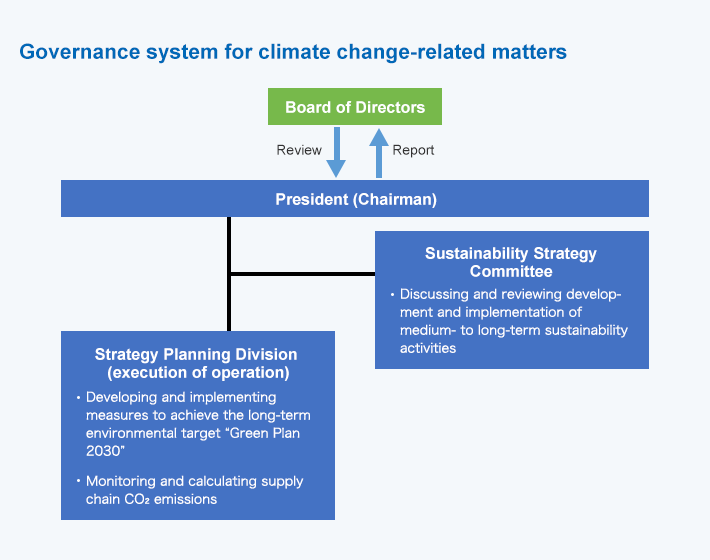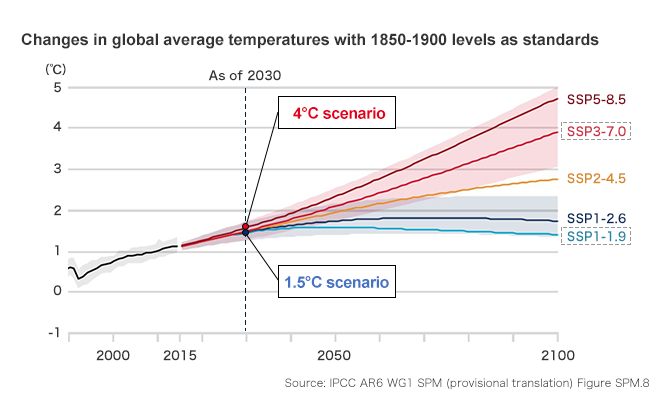Information disclosures related to climate change (TCFD disclosures)
In June 2017, the Task Force on Climate-related Financial Disclosures (TCFD), which was organized by the Financial Stability Board (FSB), recommended in its annual financial report the disclosure of climatic-related information that could have financial impacts. ESG-conscious institutional investors and financial institutions, meanwhile, emphasize that companies should incorporate climate change risks and opportunities into their business strategies while recognizing their significance, which is also mentioned in the TCFD’s report.
Tsurumi Manufacturing Co., Ltd., therefore, discloses climate-related financial information according to the TCFD’s recommendations, which concern “governance,” “strategy,” “risk management” and “indicators and targets.”
Governance
The Sustainability Strategy Committee, chaired by the president, places climate change risks at the center of the corporate business strategy, discussing and reviewing development and implementation of medium- to long-term sustainability activities. The results are regularly reported (at least once a year) to the Board of Directors for review, a system that ensures effective supervision by the Board of Directors.
At the same time, the Strategy Planning Division manages and promotes climate change initiatives, including TCFD.

Strategy
The strategy component of the TCFD’s recommendations stipulates that “companies must explain the resilience of their corporate strategies, based on review of various climate-change scenarios including the below 2°C scenario.” We analyzed both the 2°C scenario and the 4°C scenario in our information disclosure in FY2022.
As the 1.5°C scenario, which involves greater transition risks, must be taken into account to ensure resilience against an increasingly uncertain world, we developed a new world view in FY2023, followed by analysis of the 2030 scenario using the 1.5°C scenario and the 4°C scenario.
The potential impacts of climate change on business at Tsurumi were investigated using the following process:

We extracted and evaluated climate change risks and opportunities towards 2030, where the issues listed below are expected to affect our businesses, according to the risks and opportunities categorized by the TCFD.
| Categories | Risks | Expected impacts | |||
|---|---|---|---|---|---|
| Risks | Transition | Policy / Legal system |
Carbon tax | Manufacturing (self-manufacturing) |
A carbon tax will have certain impacts on overall operations, though those on financial aspects will be moderate, with efforts made to achieve the Green Plan 2030 targets by reducing GHG emissions from all business activities. |
| Material (Scope 3) |
In Category 1 of Scope 3, which accounts for about 10% of supply chain CO2 emissions, refined metal production to manufacture products generates CO2 emissions. A carbon tax is thus expected to have a significant impact on procurement costs. | ||||
| Changes in energy mix | Development of geothermal and biomass power generation is likely to contribute significantly in boosting sales while negative impacts are expected as thermal power generation continues to decline. | ||||
| Technology | Increased demand for electronic devices | Supply-demand imbalance in semiconductors, etc. due to streamlining and automation could delay manufacturing, resulting in a loss of orders and financial impacts. | |||
| Market | Increased material costs | Rising raw material costs due to increased demand for steel and rare metals are expected to have a significant impact on procurement costs. | |||
| Changes in customer behavior | Rising environmental awareness will affect customers’ choice of products and, by extension, sales of existing products. | ||||
| Physical | Chronic | Increased average temperature | The work environment will deteriorate as temperature rises, resulting in higher turnover and increased prevention costs. | ||
| Changes in rainfall patterns | Intensified rainfall could lead to increased costs in flood control due to greater flood risks. | ||||
| Rising sea levels | Coastal facilities need to protect themselves against high tides caused by rising sea levels, which could result in increased protection costs. | ||||
| Acute | Increased climatic extremes | Damage caused by increasingly frequent heavy rains and typhoons seriously affects the value chains. This could make some of our businesses unsustainable. | |||
| Categories | Opportunities | Expected impacts | |
|---|---|---|---|
| Opportunities | Products and services | Protection against greater rainfall intensity | With the rainfall intensity reviewed, there will be a growing demand for replacement of drainage facilities or improvement of their performance both in public and private sectors. This, in turn, is expected to stimulate overall demand. |
| Adaptation to various power sources | Geothermal and biomass power generation, promising power sources in the new energy mix, are expected to boost demand for vacuum devices. | ||
| Markets | Changes in customer behavior | Rising environmental awareness will lead to increased demand for products that contribute to conservation of energy and water. | |
| Progress in CCUS recovery technology | The vacuum device market is expected to grow in tandem with progress in CCUS, which uses vacuum devices in its facilities. | ||
| Energy sources | Introduction of renewable energy and promotion of energy-saving measures | There are positive reputation that leads to increased demand. | |
| Resilience | Standardization and self-manufacturing of parts and components | Measures are taken to prevent disruptions in the supply of parts arising from climate change, etc. These measures will improve corporate credibility and minimize loss. | |
Information disclosure according to the TCFD’s recommendations requires analysis of multiple scenarios including the below 2°C scenario. Accordingly, our analysis refers to IPCC SSP 1-1.9 (the below 1.5°C scenario) and SSP 3-7.0 (the 4°C scenario), the IEA scenario, and data provided by the Japanese government, with both the 1.5°C scenario and the 4°C scenario adopted and examined.

IPCC: Intergovernmental Panel on Climate Change
IEA: International Energy Agency
- Keep the rise in average temperature in 2100 below 1.5°C.
- Stringent regulations, coupled with technological innovation, will be in place to achieve net-zero CO2 emissions worldwide by 2050.
- Markets influenced by decarbonization initiatives and changes in customer preferences will impact businesses.
- The average temperature in 2100 will increase by about 4°C.
- There will be no stringent regulations or significant technological innovation due to inconsistencies in climate change policies around the world.
- Social changes triggered by climate change (higher temperatures, increased rainfall, etc.) will impact businesses.
Possible impacts are evaluated, with focus on two critical factors: uncontrollable cost risks (carbon tax, disaster risks, etc.) and issues related to flood damage and energy that would generate profit opportunities.
| Risks | Financial impacts |
Countermeasures | Time span |
|---|---|---|---|
| Impacts of carbon tax on manufacturing | Moderate | As business growth results in greater CO2 emissions from manufacturing, the introduction of a carbon tax will significantly affect profits. Our long-term environmental target “Green Plan 2030” aims to reduce our CO2 emissions in 2030 by 50% from current levels. Specific measures include introducing solar power generation facilities and promoting the use of renewable energy, all designed to achieve the reduction target and prevent profit loss due to carbon tax. A carbon tax, meanwhile, could lead to increased raw material costs. We are therefore reviewing our procurement procedures – e.g., decarbonizing our proprietary technologies and supply chains, improving their environmental performance, and ensuring stable supply. |
Short- to long-term |
| Plant shutdowns and supply chain disruptions caused by flood damage, etc. | Minor | While flood frequency is expected to double in 2030 (with a temperature increase of about 1.5°C), we are assessing our flood risks and those for our key suppliers by estimating the amount of damage at each manufacturing location and taking into account the largest possible flood expressed in hazard maps. Our measures against possible flood damage include making our electric facilities more resilient, standardizing and self-manufacturing parts and components, and continuing BCM. |
Short- to medium-term |
| Opportunities | Financial impacts |
Countermeasures | Time span |
|---|---|---|---|
| Increased sales opportunities brought about by intensified rainfall | Moderate | Intensity is expected to increase 10% in 2030 (with a temperature increase of about 1.5°C), which could impact national rainfall intensity standards. This impact, however, works to our advantage, leading to increased demand for renovation and reinforcement of rainwater drainage facilities, followed by increased value in orders. In addition, the rental industry will likely benefit from drainage-related work, temporary rainwater control and flood damage reconstruction. We are thus developing new products to meet these growing needs and improving our S&S system. | Short- to medium-term |
| Increased sales opportunities associated with the energy mix | Minor | As the energy mix changes, we are becoming less dependent on fossil fuels, and renewable energy use is growing. Accordingly, the share of thermal power generation is declining, which could affect the profits of Domestic Sales Division and Vacuum Pump Sales Division. On the other hand, demand is expected to increase for vacuum pumps for geothermal and biomass power generation, water pumps for rainwater reservoirs required for solar power generation, and products designed for nuclear power generation, each of which contributes to increasing profits. The growth of geothermal power generation in Southeast Asia, moreover, is expected to further provide sales opportunities in the Vacuum Pump Sales Division. |
Medium- to long-term |
Risk Management
We recognize the significance of climate-related issues, which pose a serious risk to our operations. We are therefore analyzing medium- to long-term changes in the market and environment through scenario planning, with the Sustainability Strategy Committee and the Board of Directors properly managing the risks and opportunities identified.
Indicators and Targets
- 1. Reduce the amount of greenhouse gases emitted from our activities to 50% of the level in FY2014 by 2030.
- 2. Reduce the intensity of greenhouse gases emitted from our supply chain activities to 30% of the level in FY2014 by 2030.
At Tsurumi, we have established our Green Plan 2030 for long-term environmental targets in order to fulfill our sustainability and social responsibilities and missions as a business. To achieve the targets set forth in this Green Plan 2030, we will look to reduce our long-term emissions of greenhouse gases in all aspects of our business activities.
FY2022 key climate change initiatives
- Announcement of the long-term environmental target “Green Plan 2030”
- Quantitative, qualitative disclosure of financial impacts according to the items recommended in the TCFD framework (1.5°C and 4°C scenarios)
- Response to the CDP Climate Change 2022 Questionnaire and information disclosure (C-rated)
- Switch to renewable energy at the Shikoku Branch Office and the Takasaki Sales Office (switch completed in or before FY2021 at the Osaka Headquarters, Tsurumi East Japan Logistics, and Tohoku Branch Office)
- Calculation and monitoring of supply chain CO2 emissions (Scopes 1, 2, and 3)





